DE-EXIT: Eternal Matters review
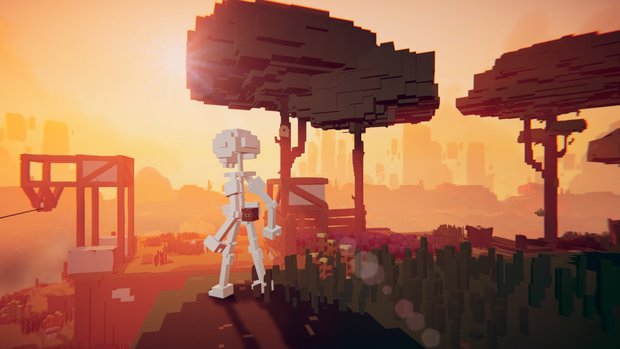
- 0 Comments
Ambitious genre-bender an uneven but lively mix of stealth, platforming and puzzles
What happens after we die? According to SandBloom Studio’s DE-EXIT: Eternal Matters, there’s one more stop before the real, forever, lights-out end. It’s a voxelated land of the dead evocative of Latin American tradition, distinct from the haunted and grim horror often associated with the afterlife, making for a deadscape that’s surprisingly upbeat and alive. Players experience this new plane of existence via a mix of 3D platforming, stealth, and puzzle solving. Though the individual parts don’t always play out as smoothly as intended, and it’s not always entirely sturdy on its feet, DE-EXIT has the bones of something special that may make it worth a bit of your time here on earth.
DE-EXIT thrusts players into the role of a nameless and mute skeleton who awakens in a strange twilight world. After a short segment of linear platforming tutorials, you’ll meet Asem, a Guardian of the realm who gives our protagonist an artefact (a sort of magic cube) after he engages in an all-too-close round of combat with a monster. You’ll then venture towards the village of Nexus, where you’re promised all will be explained.
Not surprisingly (being a skeleton and all), it turns out that you are dead, and that this is in fact the afterlife. Nexus is a village for souls of the departed in a place called the Plane of Memory. Charmingly, Nexus isn’t all that different from real life. People have lives here (well, in a sense) and work to make their town a better place to live (erm, unlive?) their second go-around. It’s a pleasant place to wander, talking to the townsfolk, reading up on lore, or even just sitting down on a park bench to watch the sunset. This isn’t a vacation, however. One of the former Guardians named Donovan has gone rogue, killing off the other Guardians in order to open a breach and return to the world of the living. This breach will destroy the Plane of Memory, including the Nexus and everyone in it, if not closed. The town rallies together to fight back, but only you, dubbed Lux by the townspeople (for being able to wield Asem’s magical box) can defeat the evil threatening the realm.
Your goal is to restore power to the pillars spread throughout five distinct regions: the oceans, a forest, the desert, a mountain range, as well as a final area that I won’t spoil here. Shadow creatures roam these outer wilds, as do giant monsters (essentially “boss” enemies), cutting off the realm’s away teams. The Nexus acts as a sort of rest area between chapters, pushing the narrative forward via conversations with the townsfolk, and allowing you to visit the local engineer, MiMi, to upgrade your artefact with new powers that will be utilized in the next level. Eventually you’ll unlock four such abilities: a flashlight, a whirlwind burst used to break destructible objects, a telekinetic ability (similar to Half-Life 2’s gravity gun), and the ability to hover above the ground and turn into a bolt of electricity, riding metal circuits. Each time you return to the Nexus the town will have changed slightly, with citizens' placement altered and new books being added to the library, for example.

There are notes and journals littered throughout the environments for those who want to learn more about the world, though these are entirely optional, and you need not worry about missing a crucial clue along the way if you opt just to stick to the main path. There are also hidden collectables in the form of soul fragments and Guardian armor, though these are entirely optional. (I only collected a handful in my playthrough, leading me to believe there is quite a bit of extra exploration one can indulge in should they wish.)
Once you venture out of the Nexus, the way forward is usually clearly marked or found with a bit of exploration. Levels are presented in a linear order, and you are not able to travel back to levels from previous chapters after completing them, though you can sometimes backtrack to re-explore areas within the current level or choose which route or set of challenges to tackle first. Some levels have a circular layout, albeit in sections, though you will be pushed toward scripted sequences frequently, breaking off connection to previous areas in the process. The third chapter takes place in a forest, for example, and has a central hub leading to three areas, each with an away team from the Nexus that needs help. You can complete these routes in any order you wish, though once committed to a route, at a certain point you will not be able to return to the central hub until completing the challenge. The fifth level also allows you to return to previously completed sections from earlier in the level via a gondola fast travel system before you ultimately commit to starting the stage’s boss battle.
DE-EXIT is a level-based 3D platforming adventure sans any direct combat, though its absence does little to detract from the game’s sense of action. The gameplay is split into three distinct modes: stealth, platforming, and puzzle solving. Stealth is the first aspect stressed, with your initial artefact power being the ability to reveal invisible monsters patrolling the areas via a flashlight beam. Their path can be observed by way of trailing black particles, and shining your light on these paths will reveal the creatures in their entirety. These monsters are slow and relatively braindead, but if you illuminate them for too long or get too close they will become alerted to your presence and can kill you in a single swipe. The flashlight power can also be used to activate certain door locks and objects, and to make particular types of grass temporarily grow taller, allowing you to better hide from the monsters.
Stealth sections sometimes allow you to take different routes, sneaking through tall grass, using environmental objects for cover, or even shuffling around in barrels. This aspect of the gameplay is, unfortunately, fairly tedious, and while the base mechanics of avoiding line of sight are sound enough, the constant need to switch the flashlight on to check where enemies are on their painfully slow patrol routes can really drag the pace down. Furthermore, you are often tasked with completing other goals while sneaking, like using Lux’s power to move an object or distract a shadow creature waiting in ambush, meaning you need to rely on the game’s collision detection and friendly AI to operate as intended, which they sometimes don’t.
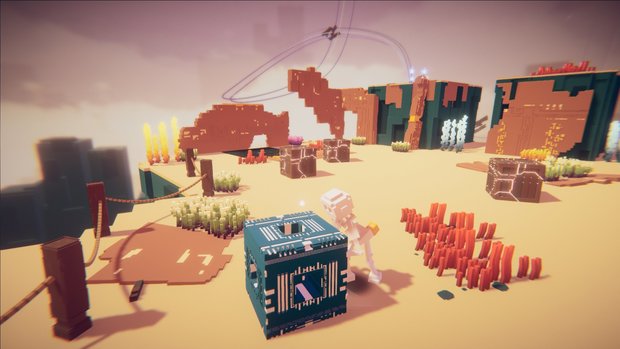
One section in the third chapter tasks you with escorting two friendly NPCs back to the central hub by slinking past several enemies. Using the telekinesis power, you must retrieve and move a series of planks to make safe passage across bodies of water. Sneaking ahead and creating bridges is straightforward enough, and the AI characters did a good job of following me when appropriate. However, when I tried to backtrack off the intended route to re-use a plank for a new bridge – because I hadn’t seen the newer one I was supposed to use – the game dissolved the plank mid-air when I tried to place it. On one hand, this forced me to rethink the scenario and explore further ahead. On the other hand, it’s a shame the game gives players sandbox tools like telekinesis but doesn’t let them freely use it to makeshift their own solutions, even if they end up being needlessly complex, like mine.
Unfortunately, taking and moving objects with the telekinetic power can be very annoying in its own right. If the object you are trying to pick up snags on something in the environment, it will sometimes adjust itself around the obstacle, while other times it will just drop or dissolve. More frustrating still, the controls in entering the focus mode to pick objects up stiffens the aiming reticle, and in high-pressure instances like the fifth chapter’s boss, the game can become quite troublesome.
Platforming is more or less sound, with the main navigation controls being running (or swimming), jumping, climbing, and crawling. Lux will auto-grab ledges you jump at if they’re close enough, and will shift to hug the wall automatically in order to navigate a short ledge. Lux won’t avoid falling off a ledge by grabbing it, however, making walking thin planks and bridges precarious. But that’s all part of the suspense, because falling from too great a height reduces Lux to a broken pile of bones, resulting in an automatic reload from the last checkpoint.
Having Lux miss a ledge is the more aggravating affair, and even after hours of gameplay, I never felt like I could quite predict whether a platform was too high or too far for Lux to grab hold of. Failure to do so usually meant the game was directing me down a different path, but the fact that I ran into so many dead ends that seemed like obvious routes was frustrating too. There is also a small quirk I experienced sometimes when climbing ladders, resulting in my having to shimmy left or right in order to get Lux to climb up onto the ledge. It’s a small complaint, but one that nevertheless feels like it could have been ironed out.
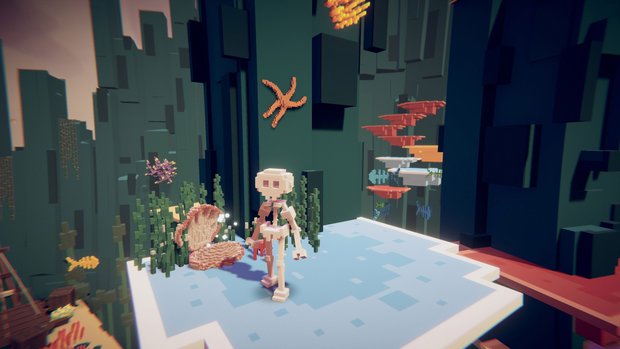
There’s some swimming (on the surface, not below) to be done, as well as riding air streams between floating islands, dispatching flotsam and jetsam polluting the stream as you glide, or swinging on vines between trees. It’s this kind of variety in platforming that makes each area feel unique, tailoring the gameplay to its specific environment.
The game stalls a bit in the first half with its reliance on stealth and the finicky use of telekinetic powers. However, the second half is far more enjoyable, with the desert, mountain, and final chapter being more focused on puzzle solving. In the desert, you have to dart between pockets of shade, lest the hot sun reduce Lux to charred bones. You’ll platform through stone ruins in order to reach sundials, which allow you to change the position of the sun and make new pockets of shade – all while avoiding predatory sand worms beneath your feet. The sundials are also well-utilized in several light beam puzzles, where you need to reflect the light via mirrors.
The mountain chapter has you exploring abandoned mines, reactivating and adjusting rail tracks. You’ll have unlocked an electrical dash ability at this point, allowing Lux to float for a short distance, as well as turn into a bolt of electricity and ride through circuits. The switch and box puzzles in this level are challenging, forcing you to move about the environment and tinker with switches and pressure plates, making small adjustments until your path is clear. It’s textbook adventure stuff, but it’s no less fun because of it, and DE-EXIT is most enjoyable in these sections.
The boss battles at the end of each chapter are mostly great fun too. Since you can never win by brute force, one has you sneaking around the perimeter of a tower, trying to climb it while a giant snake watches on from the interior, forcing you to dash between cover quickly to avoid its spotlight gaze. Another one against a giant jackal named Anubis is less enjoyable, forcing you back into stealth mode as you move between hiding spots before the beast picks up on your scent, all the while trying to cobble together bridges with the aforementioned finicky telekinetic power. The fourth chapter’s boss is highly entertaining, with a sand skiff sequence followed by a chase through a library that almost feels like a modern version of Pac-Man, flicking switches to let the sun in while the boss chases you through the grid of shelves, the camera following the action from overhead.
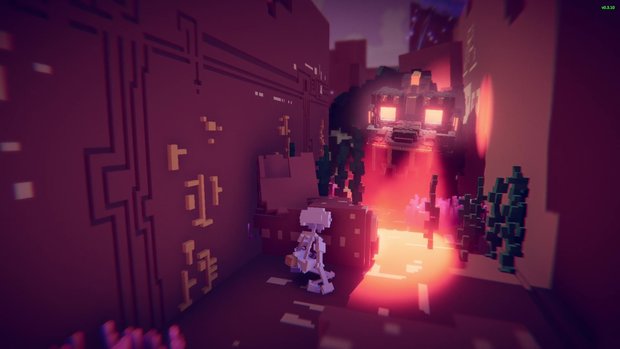
For those hoping for a more casual puzzle-centric experience, be forewarned that there are several tricky action segments. The fifth chapter’s boss feels reminiscent of an arcade game too, making you switch between your powers on the fly. The final boss fight requires some dexterity as well, though the less said about that the better, except that it changes things up yet again. If you can handle the increased action at times, the fact that DE-EXIT can keep you engaged with new surprises throughout the entire eleven-hour runtime is a notable accomplishment.
DE-EXIT utilizes Quick Time Events during certain scripted action sequences and boss battles. They effectively heighten the suspense and further lend the game a cinematic flair, and failure usually doesn’t send you back very far (though some boss battles can be more punishing). In fact, the scripted sequences are so well-woven into the gameplay that whether running away from a giant skeleton chasing you across a collapsing bridge, or calmly rowing yourself across a lake, it’s easy to forget that DE-EXIT is an indie game and not a AAA production.
Saving is automatic, which usually isn’t a problem except that checkpoint placement can sometimes force you to redo tedious tasks, like setting up NPCs for a sequence before a platforming segment, or having in-game chatter between characters repeat as you search for the correct route through a section, only to die and have to hear the same speech multiple times.
Cinematics are frequent, and conversation between characters often fills the void while playing. While you don’t spend much time with any given character, I was surprised to find how impactfully the game’s climax hit. After my long journey across this colourful land of the dead, I had become invested in the drama of the whole situation, even though I would have liked to get to know some of the supporting characters better. The game’s incredible cinematography and motion capture, along with a fully voiced cast (aside from Lux) are largely responsible for this emotional attachment, with all of the actors doing a fine job of inhabiting their on-screen personas. The score is an epic mix of electronica and swelling orchestrated segments, while downbeat music perfectly suited for thinking your way through puzzles plays during the quieter bits. Some of the music is almost akin to John Williams’ Harry Potter compositions, suitably lending the game a magical atmosphere.
The skeletons are all made of the same base model, though individual clothing and makeup arrangements give each NPC a distinct personality, ensuring it’s never hard to differentiate between characters. The voxel design is very pretty, though it’s not as clean as one might expect of a geometric system. Clipping is commonplace, and aspects like the skeletons’ neck/spinal columns being a single rectangular piece instead of individual blocks makes the twisting motion of the characters’ heads look weirdly strained. However, the large boss monsters, as well as the creatures like skeleton foxes, birds, and even whales populating the levels are meticulously crafted and animate with incredible fluidity, lending a charming sense of wonder to DE-EXIT’s extended world.
The environmental constructions are top notch, with everything from foliage to mechanical parts and ancient ruins rendered beautifully by clusters of tiny voxels. The cuneiform writing in the ruins, for example, glows with neon colours, and combined with the game’s impeccable lighting and atmospheric effects, gives each area a convincing aura of mystery. Furthermore, the voxels are used to texture and undulate surfaces, cuts, and cracks, making them feel all the more authentic and moulded. Flourishes like morphable snow as you walk through it really show off SandBloom’s use of the technology, making the world as detailed as possible.
The camera is mostly reliable, being dynamic enough to zoom out and give you a good view of the environment you are exploring while not being so far away that you can’t see the finer touches. I played the game with a keyboard and mouse (though gamepads are not only supported, the developers recommend one), using the latter to guide the camera most of the time, and it never felt like I was fighting the game for control. The camera will adjust itself during scripted action sequences, but these are always framed well.
I experienced several graphical oddities, like the letterbox bars that appear for cinematics sometimes not extending all the way to the top and bottom of the screen. I also had a gear-turning sound effect get stuck on loop once, and I had to restart the game in order to stop it. In another section, the text overlays in a character’s dialogue overlapped and garbled together, making their subtitles unreadable. Fortunately with all the characters being voiced, I was still able to discern what was being said. I also got stuck between two objects in the environment once, and again had to reload in order to get myself free.
Final Verdict
It may not be the most polished game, but it’s surprisingly ambitious, featuring an engaging narrative that is expertly told through a mix of interactive segments, cinematics, and environmental design. The stealth sections aren’t much fun, and the platforming can feel a tad unpredictable, but the variety of challenges and the puzzle design in the second half of the game make it worth pushing through in spite of its potential frustrations. It’s definitely one for those who don’t mind a little action in their adventure, but if that’s you, DE-EXIT: Eternal Matters is an afterlife worth visiting.
Hot take
DE-EXIT is an ambitious and mostly well-crafted adventure, with great puzzle design, charming visuals, and an immersive cinematic flair. Not all of its ideas play out equally well, and a slow first half combined with minor technical issues make it a bit hard to break into, but those who stick with it until the end won’t regret the effort.
Pros
- Enchanting use of voxel art style
- Expertly crafted cinematics and sound design
- Great puzzles in the second half of the game
- Engaging narrative creates a surprisingly powerful emotional investment
Cons
- Stealth segments aren’t much fun
- Finicky controls when using the telekinetic power
- Several audio and graphical hiccups
Drew played DE:EXIT: Eternal Matters on PC using a review code provided by the game's publisher.







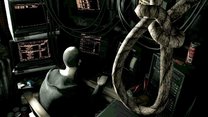


0 Comments
Want to join the discussion? Leave a comment as guest, sign in or register in our forums.
Leave a comment